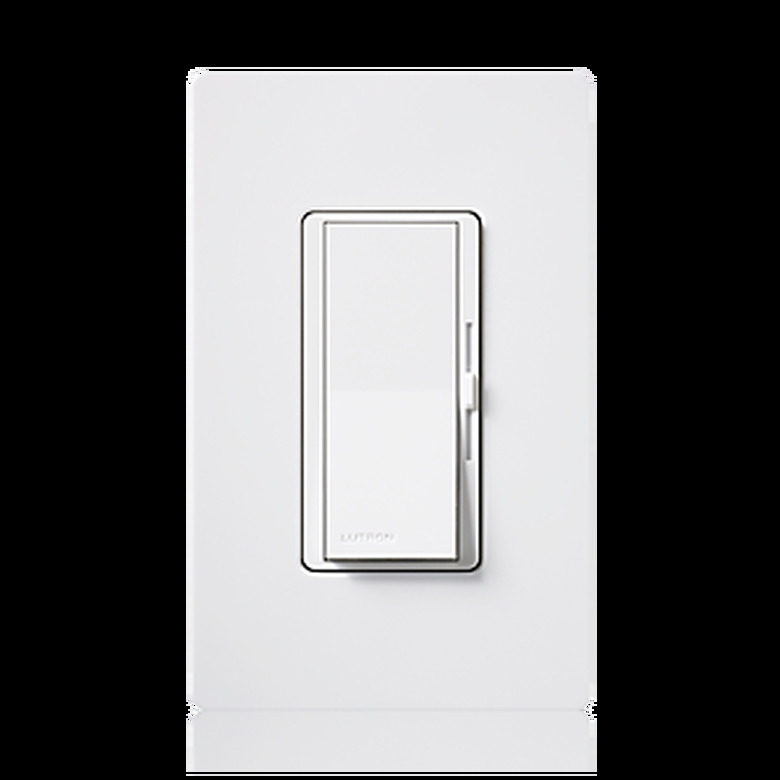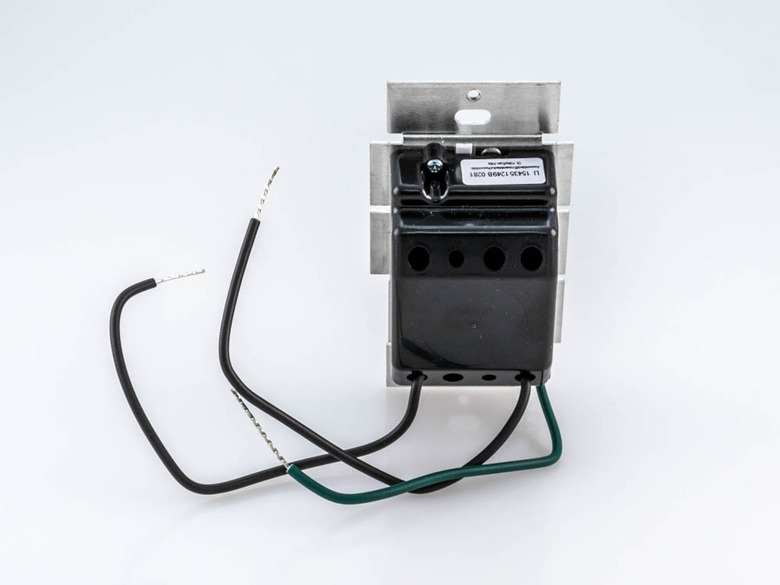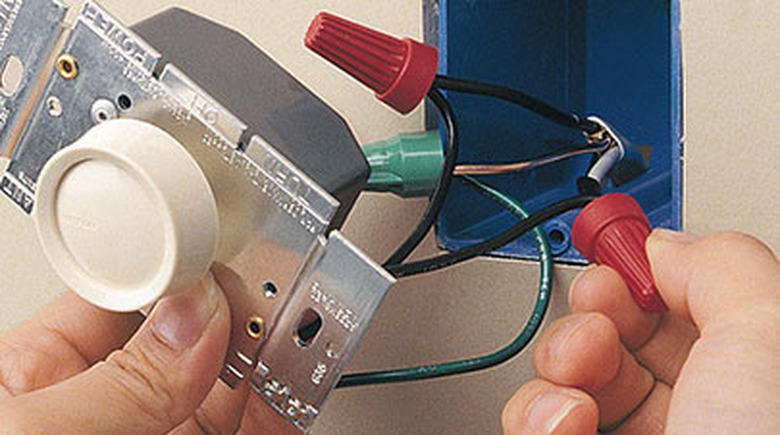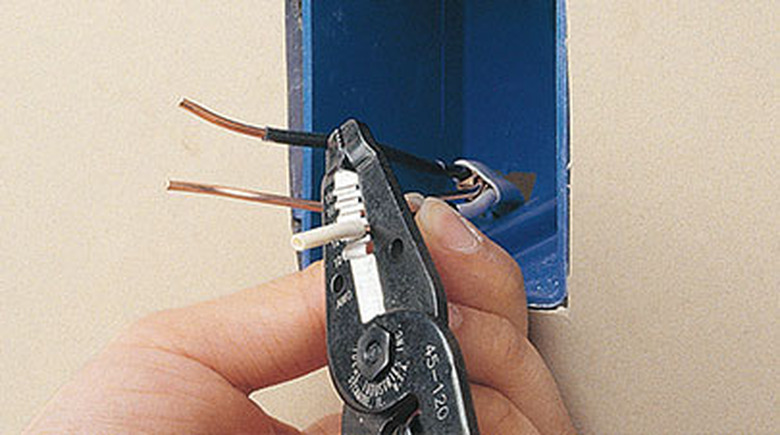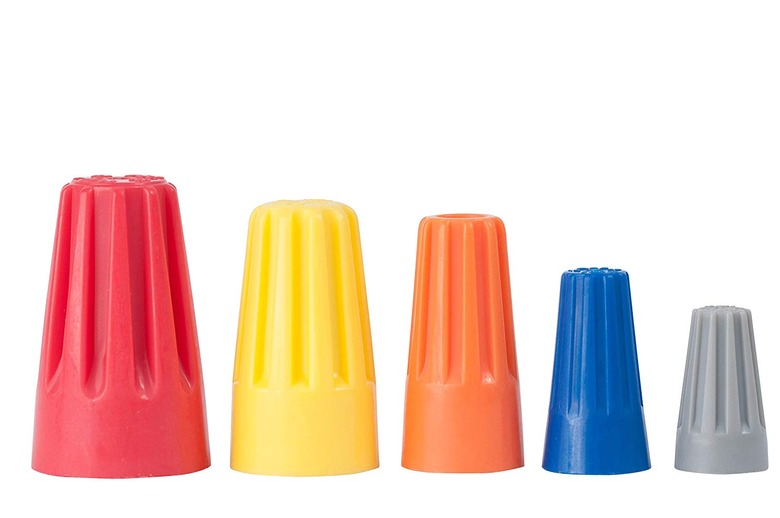How To Install A Dimmer Switch
Although they look a little different, dimmer switches are installed much like standard light switches. The project starts with shutting off the power at the breaker and confirming the power is off before touching any wires. Once you have the old switch out of its electrical box, you can examine the circuit wiring. If the switch is at the end of its circuit (called end-of-run), it will have only one electrical cable (containing multiple wires) in the box. If the switch is in the middle of the circuit (middle-of-run), it will two and sometimes more cables in the box. In either case, each wire lead on the dimmer should connect to only one circuit wire, although the ground lead might connect to more than one wire.
Choosing a Dimmer Switch
Choosing a Dimmer Switch
If you're replacing a standard toggle switch that controls a light from a single location, you'll need a single-pole dimmer. There are also three-way dimmers that work with regular three-way switches to provide dimmer control at one of the two switch locations (the regular switch just turns the light on an off; no dimmer control). Be aware that all dimmer switches have larger bodies than standard switches and need a little room in their electrical box to dissipate heat (dimming creates some heat due to electrical resistance). If the switch box is small or has a lot of wires in it, you may need to upgrade to a larger box so the dimmer fits in without cramming it against the wires.
Aside from the single pole vs. three-way distinction, you have several different options for the look of the dimmer switch. Some have standard toggle levers, while others work on touch-sensitive slide pads or other mechanisms. Some have a number of preset incremental settings for dimming the light fixture to specific illumination levels.
Unlike standard switches, most dimmer switches have wire leads that are connected to the circuit wires with wire connectors, rather than using screw terminal connections.
Do LEDs Need Special Dimmers?
Do LEDs Need Special Dimmers?
Since most people have wisely switched to LED light bulbs these days, you may have heard about problems with dimmers and LEDs. Here's a quick update: Old LED bulbs typically weren't dimmable and required special LED dimmer switches. But today, many LED bulbs are dimmable and work with most types of dimmer switches. However, compatibility between the dimmer technology and the light bulb's electronics can be an issue. Namely, poorly matched dimmers and bulbs can lead to flickering lights and/or limited dimming range—lights shutting off before the dimmer gets to its lowest setting.
Major switch manufacturers, such as Leviton, publish compatibility reports that tell you which major-brand bulbs work best with their dimmers. Once you've chosen a dimmer, look to the compatibility report and choose a bulb with the best performance rating. This may seem like overkill, and if you might just decide to go with any old dimmer and any dimmable LED, you probably won't have complaints. But quality LED bulbs last for many years (up to 50,000 hours of use), so it makes sense to find a good match.
Things Needed
-
Non-contact voltage tester
-
Screwdrivers
-
Electrical tape (as needed)
-
Needlenose pliers
-
Wire strippers (as needed)
-
Single-pole dimmer switch
-
Wire connectors
How to Install a Single-Pole Dimmer Switch
1. Turn Off the Power
Shut off the power to the switch circuit by turning off the appropriate breaker in your home's service panel (breaker box). Remove the screws on the switch's cover plate, and remove the cover plate. Without touching any wires, use a non-contact voltage tester to test the switch terminals and each wire in the box to confirm that there is no voltage. If the tester lights up, indicating live voltage, return to the breaker box and switch off the correct breaker, then retest for voltage at the box.
2. Examine the Switch Wiring
Remove the two screws holding the switch to the box. Carefully pull the switch straight out from the box, extending the circuit wires. Note the switch wiring:
- If there is th the one cable entering the box, the switch is wired in end-of-run configuration. The cable may have two "hot" wires (usually black and red) connected to the switch's side terminals, a neutral wire (usually white) not connected to the switch, and a ground wire connected to the switch's ground screw. If the box is metal, there may be an extra, short wire (called a pigtail) connected to the ground wires and the metal box; metal boxes require grounding, while plastic boxes do not. If the cable has only a black, a white and a ground wire, and the white wire is connected to the switch, this is being used as a hot wire, not a neutral. It should be labeled with a band of electrical tape to indicate it is hot; add this tape, if necessary.
- If there are two cables entering the box, the switch has middle-of-run configuration. The switch may connect to two black hot wires or a black hot and a red hot. The white wires from the cables will be connected together but will not connect to the switch.
Whatever the circuit configuration, the two wires attached to the switch, along with the green ground wire, will be the wires that will connect to the new dimmer switch.
3. Remove the Old Switch
Loosen each screw terminal on the side of the switch and pull the wire off of the terminal. Do the same with the ground wire, and remove the switch.
4. Prepare the Circuit Wires
Straighten the end of each switch wire, using needlenose pliers. Inspect the bare wire end: It should be in good condition and have about 1/2 of bare wire extending beyond the wire insulation. If the end is nicked, scorched or otherwise damaged, cut off the damaged portion, then strip the insulation back to 1/2 inch, using wire strippers.
5. Connect the Dimmer
Connect one of the hot wire leads (usually black or red) on the dimmer switch to one of the hot circuit wires, using a wire connector (wire nut). Twist the connector firmly, then tug lightly on each wire to make sure it is secure. The hot leads are interchangeable on a single-pole switch; either one can connect to either hot circuit wire. Connect the other hot switch lead to the other hot circuit wire, using a wire connector.
Connect the switch ground lead (usually green) to the ground wire(s) in the box, using a connector. There may be more than one ground wire in the box. Each circuit cable should have a ground, and, if the box is metal, there should be a short ground wire (called a pigtail) connected to the box. Join all of the ground wires under the same wire connector.
6. Mount the Dimmer
Carefully tuck the wires into the electrical box, folding them neatly, as needed. Mount the dimmer to the box using the two provided screws. Make sure the switch is straight up-and-down. Fit the new dimmer cover plate into place and secure it to the box or switch, as applicable, with the provided screws.
7. Turn On the Power
Switch on the circuit's breaker to restore the power. Test the switch for proper operation.
Tip
If you're using an LED bulb and it flickers or it turns off well before the dimmer reaches its lowest setting (most LEDs cut out a little bit early, even when they are well matched to the dimmer), try a different bulb, preferably a model recommended by the switch manufacturer.
